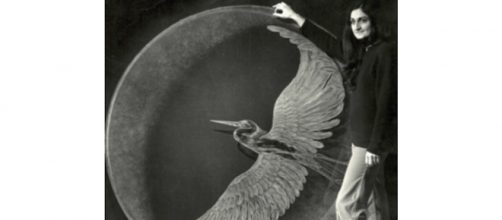Diamond Point Hand Engraving is the artistic medium of Marlies, a self-taught artist who was born in Switzerland and now resides in the United States. Marlies established her unique style by using a customized diamond point to create stylistic hand-drawn engravings. She presently creates her stunning work by placing many glass panels together and then engraved them from both the front and the back. Moreover, she also carves designs on glass and crystal balls.
When combined with light against a black backdrop, the transparency of the glass gives Marlies’ drawings the illusion of floating in space or are encapsulated in ice.
The message of her work is to appreciate life, nature, and beauty.
Marlies work was recognized in the mid-1970s and two pieces were chosen by the United States Government to present America at an Art exhibition in honor of the 1976 Bicentennial Celebration. The display was installed at the World Trade Center.
At present, Marlies primarily creates art on commission, largely for private collections. She recently discussed her career as a glass engraving artist and more via an exclusive interview.
Art, glass, and engravings
Meagan Meehan (MM): When and how did you get into making art, and how did you settle on the glass as a medium?
Marlies Hersperger (MH): The carving came from when I was a child.
My mother gave me this pencil-shaped rod with a diamond on the tip. I was told to carve decoration in old fancy bottles for gifts on holidays. Later in life, when I needed a job, I went back to carving on glass plate and developed more technic. The art came to me naturally.
MM: How did you learn how to engrave glass and how did you create a style that is distinctively yours?
MH: I never had art classes. This art form came naturally to me. I did perform some of my art with sandblasting. I would sandblast multiple levels.
MM: You are originally from Switzerland, so when did you come to America and what were some of the biggest differences you saw in the American Art scene versus the Swiss art scene?
MH: I came in 1967. There was plenty of culture in both countries. However, in Switzerland, the culture is scattered over the country. In America, the art culture is localized more in the cities.
Bicentennial, opportunities, and sculpture
MM: How did you get selected to be part of the 1976 Bicentennial exhibition?
MH: President Ford had a Bicentennial commission who my agent contacted. I did a piece to show my work to the commission, The SeaWitch Clipper ship. The commission accepted my work and I produced two works for the Bicentennial.
MM: How have you found opportunities to show your art and how many commissions do you work on each year?
MH: My first works were by word of mouth from a local glass retailer.
Then an agent was responsible for some of the commissions. After the agent stole some of my works and disappeared, I joined the Art Alliance of Monmouth County. The sculpture artist Geza de Vegh was responsible for one of my large pieces. The Midland Glass Co. wanted a glass bust of the retiring president. They could not find anyone to do the sculpture. Geza de Vega knew of my glass work, and I met with him to discuss what needed to be done. This was one of my more interesting commissions. The base of the glass plate was made of marble which I carved to hold the glass and the lights.
MM: How long does it take you to complete a glass engraving/sculpture?
MH: One piece was of Robert Brennan of First Security which was commissioned by his wife.
This piece was a rush job and took about 200 hours.
MM: What was your recent experience at NYC ArtExpo 2019 like and what is happening next for you?
MH: The NYC ArtExpo was wonderful. Everyone was interesting. We are still in the process of going through the information to decide what to do next with my remaining art.


